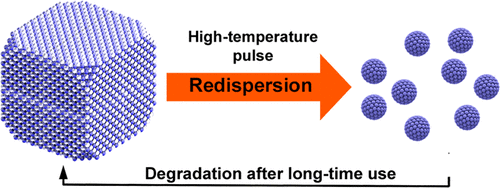当前位置:
X-MOL 学术
›
J. Am. Chem. Soc.
›
论文详情
Our official English website, www.x-mol.net, welcomes your
feedback! (Note: you will need to create a separate account there.)
A High-Temperature Pulse Method for Nanoparticle Redispersion
Journal of the American Chemical Society ( IF 14.4 ) Pub Date : 2020-09-11 , DOI: 10.1021/jacs.0c04887 Hua Xie 1 , Min Hong 1 , Emily M Hitz 1 , Xizheng Wang 1 , Mingjin Cui 1 , Dylan J Kline 2 , Michael R Zachariah 2 , Liangbing Hu 1
Journal of the American Chemical Society ( IF 14.4 ) Pub Date : 2020-09-11 , DOI: 10.1021/jacs.0c04887 Hua Xie 1 , Min Hong 1 , Emily M Hitz 1 , Xizheng Wang 1 , Mingjin Cui 1 , Dylan J Kline 2 , Michael R Zachariah 2 , Liangbing Hu 1
Affiliation

|
Nanoparticles suffer from aggregation and poisoning issues (e.g., oxidation) that severely hinder their long-term applications. However, current redispersion approaches, such as continuous heating in oxidizing and reducing environments, face challenges including grain growth effects induced by long heating times as well as complex procedures. Herein, we report a facile and efficient redispersion process that enables us to directly transform large aggregated particles into nanoscale materials. In this method, a piece of carbon nanofibers was used as a heater and high treatment temperature (~1500-2000 K) is rapidly elevated and maintained for a very short period of time (100 ms), followed by fast quenching back to room temperature at a cooling rate of 105 K/s to inhibit sintering. With these conditions we demonstrate the redispersion of large aggregated metal oxide particles into metallic nanoparticles just ~10 nm in size, uniformly distributed on the substrate. Furthermore, the metallic states of the nanoparticles are renewed during the heat treatment through reduction. The redispersion process removes impurities and poisoning elements, yet is able to maintain the integrity of the substrate due to the ultra-short heating pulse time. This method is also significantly faster (~ms) compared to conventional redispersion treatments (~ hours), providing a pragmatic strategy to redisperse degraded particles for a variety of applications.
中文翻译:

一种用于纳米粒子再分散的高温脉冲方法
纳米颗粒存在严重阻碍其长期应用的聚集和中毒问题(例如,氧化)。然而,目前的再分散方法,例如在氧化和还原环境中连续加热,面临着挑战,包括由长时间加热引起的晶粒生长效应以及复杂的程序。在此,我们报告了一种简便有效的再分散过程,使我们能够将大的聚集颗粒直接转化为纳米级材料。在该方法中,使用一块碳纳米纤维作为加热器,快速升高处理温度(~1500-2000 K)并保持很短的时间(100 ms),然后快速淬火回室温以 105 K/s 的冷却速度抑制烧结。在这些条件下,我们证明了大的聚集金属氧化物颗粒重新分散成尺寸仅为 ~10 nm 的金属纳米颗粒,均匀分布在基材上。此外,纳米粒子的金属状态在热处理过程中通过还原而更新。再分散过程去除杂质和毒化元素,但由于超短的加热脉冲时间,能够保持基板的完整性。与传统的再分散处理(~小时)相比,这种方法也明显更快(~ms),为各种应用提供了一种重新分散降解颗粒的实用策略。纳米粒子的金属状态在热处理过程中通过还原而更新。再分散过程去除杂质和毒化元素,但由于超短的加热脉冲时间,能够保持基板的完整性。与传统的再分散处理(~小时)相比,这种方法也明显更快(~ms),为各种应用提供了一种重新分散降解颗粒的实用策略。纳米粒子的金属状态在热处理过程中通过还原而更新。再分散过程去除杂质和毒化元素,但由于超短的加热脉冲时间,能够保持基板的完整性。与传统的再分散处理(~小时)相比,这种方法也明显更快(~ms),为各种应用提供了一种重新分散降解颗粒的实用策略。
更新日期:2020-09-11
中文翻译:

一种用于纳米粒子再分散的高温脉冲方法
纳米颗粒存在严重阻碍其长期应用的聚集和中毒问题(例如,氧化)。然而,目前的再分散方法,例如在氧化和还原环境中连续加热,面临着挑战,包括由长时间加热引起的晶粒生长效应以及复杂的程序。在此,我们报告了一种简便有效的再分散过程,使我们能够将大的聚集颗粒直接转化为纳米级材料。在该方法中,使用一块碳纳米纤维作为加热器,快速升高处理温度(~1500-2000 K)并保持很短的时间(100 ms),然后快速淬火回室温以 105 K/s 的冷却速度抑制烧结。在这些条件下,我们证明了大的聚集金属氧化物颗粒重新分散成尺寸仅为 ~10 nm 的金属纳米颗粒,均匀分布在基材上。此外,纳米粒子的金属状态在热处理过程中通过还原而更新。再分散过程去除杂质和毒化元素,但由于超短的加热脉冲时间,能够保持基板的完整性。与传统的再分散处理(~小时)相比,这种方法也明显更快(~ms),为各种应用提供了一种重新分散降解颗粒的实用策略。纳米粒子的金属状态在热处理过程中通过还原而更新。再分散过程去除杂质和毒化元素,但由于超短的加热脉冲时间,能够保持基板的完整性。与传统的再分散处理(~小时)相比,这种方法也明显更快(~ms),为各种应用提供了一种重新分散降解颗粒的实用策略。纳米粒子的金属状态在热处理过程中通过还原而更新。再分散过程去除杂质和毒化元素,但由于超短的加热脉冲时间,能够保持基板的完整性。与传统的再分散处理(~小时)相比,这种方法也明显更快(~ms),为各种应用提供了一种重新分散降解颗粒的实用策略。











































 京公网安备 11010802027423号
京公网安备 11010802027423号